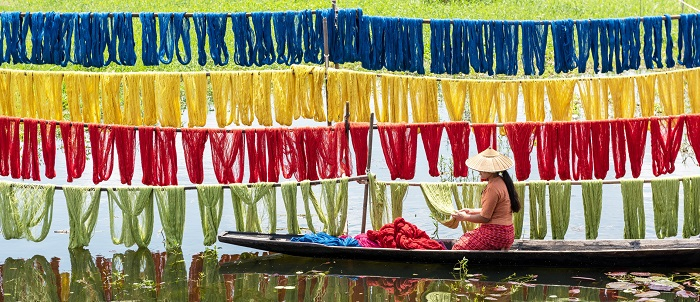

Human-made clothing, fabrics, or textiles are composed of numerous components. Like the components of a meal, the dyes, fabrics, yarns, threads, and embellishments that join together to create a finished textile Textiles are characterised by their most fundamental elements, just as good cooking is defined by employing the best ingredients. Any textile starts with the fibre, a thin material that is noticeably longer than it is wide. A fibre typically appears like hair because it is hundreds of times longer than it is wide. Almost every feature of a completed cloth can be defined by its fibres. Therefore, you must start with the appropriate materials if you want your textile to be something you’re glad to display. Although fibres are crucial to the creation of fabrics, you should be aware that not all fibres are appropriate for use in textiles.

Fibers that may be spun into yarn or used to create fabric directly are known as textile fibres. This means that they must be sturdy to maintain their shape, malleable to be woven into fabric or yarn, elastic to stretch, and long-lasting. The minimum length requirement for textile fibres is 5 millimetres. Spinning cannot be done with shorter fibres. The conclusion is that while all textiles are comprised of fibres, not all fibres can be utilised to create textiles. For instance, cotton plants have strong, flexible fibres that may be spun into yarn.
Fiber is a type of material that comes in the shape of thin, continuous strands. Yarn is the name for a pulled and twisted strand of fibre used to produce fiber. Fabrics are composed of yarn, which itself is composed of fibre. Fabric is produced on a loom using yarn. Looms can be either manual or powered. Clothes are produced using fibres. When using two yarns, one is used lengthwise and the other crosswise. Weft is the name for the yarn woven crosswise. In other terms, a fibre is any material, natural or artificial, with a high length-to-width ratio and properties that make it appropriate for being processed into fabrics. The billions of atoms that make up fibres are linked together in millions of long molecular chains.
Fabric and fibres are classified into two types: natural and synthetic. Let’s learn about the various fibre types and which are used the most frequently.
Natural fabric fibres are derived from organic materials such as plants, animals, or minerals and do not undergo any fibre production or reformation.
One of the most popular fibres in use today is cotton. It develops around the cotton plant’s seeds in the shape of a boll.
Although it’s typically created from sheepskin, “wool” can also refer to garments made from the hair of other animals.
Linen is a more popular name for flax. The fibres found inside the flax plant’s stem are used to make this type of
Fiber is a substance that the silkworm produces when it creates its cocoon, and fibre makes up the majority of silk. It is one of the most expensive fibres since it needs a lot of handling and processing.
The stems of jute plants are where the fibres for jute are harvested. Jute farming is best suited to a warm, humid climate. The majority of the time, jute fibres are used to make handlooms, bags, carpets, etc.
Natural fibre known as “coir” is taken from the coconut’s outer husk. As a result, it is also known as coconut fibre; coir is used to make mattresses, brushes, floor mats, and other household items.
In manufacturing facilities, chemical molecules known as polymers are converted into synthetic or manufactured (man-made) fibers
The most popular synthetic fibre is polyester. Coal, petroleum, air, and water are used in a chemical reaction to create synthetic polyester.
The first synthetic fibre ever produced was rayon. A synthetic fibre made from regenerated cellulose is rayon. It is created from cellulose that has been refined and chemically changed into a soluble substance, primarily from wood pulp.
The right monomers, which are the basic building blocks of polymers, are joined to form a lengthy chain to create nylon by a condensation polymerization reaction.
We can state that acrylic costs less than wool. Among other things, polyacrylonitrile is used to make sweaters and blankets.
The early men covered their bodies with animal skin and leaves. But over time, people mastered the technique for removing fibres from both plants and animals. Humans then started weaving them into clothing. Since the beginning of time, every aspect of a person’s essential necessities, such as food, shelter, and clothing to make life more comfortable, has undergone constant change. Over the years, clothing has evolved into one of the most significant aspects of human civilization. A textile product’s aesthetic appeal, usefulness, care, and comfort can all be attributed to its fibres, yarns, fabric composition, and finishes. In order to create cloth, fibres are crucial. Since fibres are the fundamental component of the majority of garments, learning about fibres and their performance is crucial for fashion designers. Making the proper fabric choice will be simpler if one understands how these elements affect how a garment fits and moves. To put it another way, a fibre is a length of thin material that can be knitted or woven into a fabric. They don’t just make the fabric; they also have an impact on the cost, comfort, durability, look, retention, and aesthetics of the finished garment.
Last but not least, keep in mind that not all textile fibres are created equal. Every fibre has a unique composition that will produce a unique textile. Some dyes hold dye very well; some are more lasting; some are more comfortable; and some retain heat more effectively than others. Understanding the ideal fibres for the task is necessary to produce the finished textile as desired. Consider fibres as culinary spices. Although you can add any spice to any dish, only the right spices will give the food its proper flavour.